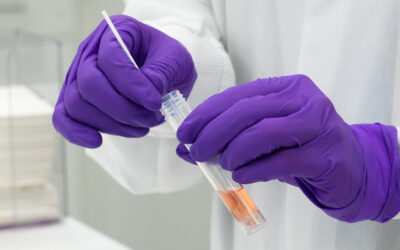Sepsis is estimated to affect more than 30 million people worldwide every year6 and is also one of the leading causes of death in hospitals throughout the United States7. To raise awareness of this condition, several organizations recognize September as Sepsis Awareness Month.
About Sepsis
Sepsis is the body’s extreme response to an infection such as a urinary tract infection, pneumonia, or blood infection9. Sepsis occurs when chemicals are released into the bloodstream to fight the infection which triggers inflammatory responses throughout the body. This inflammation can cause serious complications such as tissue damage, organ damage, and potentially death6, 7.
Many doctors view sepsis as a three-stage syndrome. The goal is to treat sepsis during its early stage because it becomes deadlier as it progresses8.
- Stage 1: Sepsis
- Stage 2: Severe Sepsis
- Stage 3: Septic Shock
Anyone affected with an infection can progress to sepsis conditions; however, vulnerable populations such as hospitalized patients, people with auto-immune diseases, pregnant women, and elderly people are at a higher risk6.
There are two primary ways to prevent sepsis:
- Preventing microbial transmission and infection by ensuring effective hygiene practices and by having functional infection prevention and control programs in your facility.
- Preventing the evolution of sepsis by ensuring patients are on the appropriate antibiotic treatment for their infections. The progression of sepsis can be slowed if patients seek prompt medical treatment, they are reassessed for optimization, and the detection of sepsis signs and symptoms are addressed immediately6.
Importance of Clinical Testing for Sepsis
Since sepsis is a complicated and deadly condition, clinical testing is used to improve patient outcomes. As time to result is critical in diagnosis of bloodstream infections, a variety of methods are used to diagnose patients that allow healthcare providers to choose the optimal treatment. When sepsis is suspected a patient is typically given broad-spectrum antibiotics and fluids while tests are performed since some tests used to diagnose the condition can take days to complete. Delayed treatment of sepsis can lead to organ failure or death according to the Centers for Disease Control and Prevention (CDC)2.
Testing Methods
Infections found in any organ system or area of the body may cause a person to become septic. For this reason, there is no single test with a clear positive or negative result for sepsis. Multiple laboratory tests are used in conjunction to provide a clinical diagnosis for the condition. Methods that are not culture-based include urinalysis and complete blood count tests among many others that detect specific factors linked to system-wide infections.
Several culture-based or organism-specific testing methods are available for clinical use:
Culturing
According to the CDC1, there are common bacteria species that are often implicated in sepsis: Staphylococcus aureus, Escherichia coli, and some strains of Streptococcus. However, the root cause of sepsis is not always these organisms. Many types of pathogenic microorganisms can cause the condition including viruses, yeasts, and bacteria.
When a systemic infection is suspected, a blood sample is often taken and input into a commercially available blood culture system. This allows any organisms present in the blood samples to be grown for downstream testing and species typing.
IVD Assays
Several in-vitro diagnostic (IVD) assays are available that can be used to quickly determine the identity of the organism or organisms growing within a positive blood culture bottle:
- BioFire® FILMARRAY® Blood Culture Identification (BCID) Panel tests for gram-positive and gram-negative bacteria as well as yeasts and certain antibiotic resistance markers.
- GenMark ePlex Blood Culture Identification (BCID) Panels test for fungal organisms, gram-negative organisms, and gram-positive organisms.
- Luminex© VERIGENE® Gram-Negative Blood Culture Test can be used to identify gram-negative bacteria and certain antibiotic resistance genes.
- Luminex© VERIGENE® Gram-Positive Blood Culture Test identifies certain gram-positive bacteria and select antibiotic resistance markers
The time to a sepsis diagnosis is critical. Using a combination of the right tests can produce improved patient outcomes. Microbiologics offers a variety of quality control products to help your laboratory ensure accurate results when testing for blood infection pathogens including:
- Blood Culture Identification (BCID) Control Panel (Inactivated)
- Blood Culture Identification (BCID) Verification Panel (Inactivated)
- Blood Culture Identification (BCID) Verification Panel (Live Culture)
- Nanosphere Verigene® Gram-Positive Blood Culture Control Panel (Inactivated)
- Nanosphere Verigene® Gram-Negative Blood Culture Control Panel (Inactivated)
- View all live culture strains
Learn More
Visit the Sepsis Awareness Month website to find out how you can spread the word about sepsis this September.
If you’d like to learn more about our BCID controls, please fill out the form below. We’ll help you find the strains your lab needs in a format that makes QC simple.
[ccf_form id=”5757″]
Read Next – Clinical Case File: Vaginitis
Resources
1: https://www.cdc.gov/vitalsigns/pdf/2016-08-vitalsigns.pdf
2: https://www.cdc.gov/sepsis/pdfs/hcp/HCP_infographic_protect-your-patients-from-sepsis-P.pdf
3: https://www.luminexcorp.com/gram-positive-blood-culture/
4: https://www.luminexcorp.com/gram-negative-blood-culture/
5: https://www.biofiredx.com/filmarraybcid/
6: http://www.who.int/news-room/fact-sheets/detail/sepsis
7: https://www.sepsis.org/sepsisawarenessmonth/
8: https://www.mayoclinic.org/diseases-conditions/sepsis/symptoms-causes/syc-20351214
9: https://www.cdc.gov/sepsis/what-is-sepsis.html






0 Comments